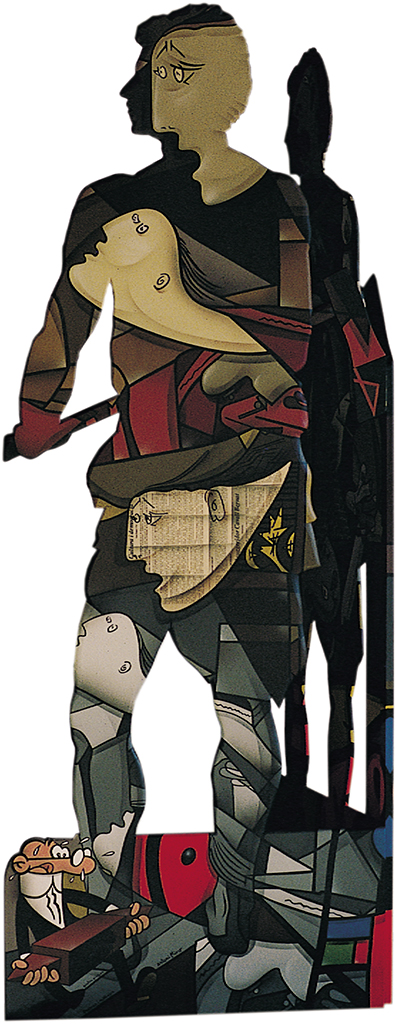Enclusa i mallaire (Anvil and hammer operator)
In the ‘Paint Painting’ series, fragments of some masterpieces of art history canon are incorporated in the artist’s compositions. They are formally transformed and their meanings changed. Miró uses irony to build a new meaning that draws on the communicative power of canonic works.
Leaving aside the mythological episode narrated in Velázquez’s La fragua de Vulcano [Apollo in The Forge of Vulcan], the artist makes the figure occupying the centre of this masterwork stand out (one of the hammer-wielding assistants, who is shown from behind). Taking the outline of this secondary character in the original work, secondary regarding the message of the scene but essential from a pictorial perspective because of the quality used to define his anatomy, Miró renders two flat wooden figures (one figure being like the original, the other its symmetrical duplicate). The figures are joined through a vertical, right-angled dihedron which, together with the square mirror on the inner part of the base, constitutes the structure of this painting-object.
Over this multiple support (the two figures from the right also show reverse images and are reflected in the mirror) the artist incorporates collage elements borrowed from Picasso’s Guernica, several works by Joan Miró, and references to popular culture. There is a hybridisation of high culture on the temporal plane: The new painting style of the 20th Century is ‘tattooed’ on the classical forms of the 17th Century. However, low culture is also thrown into the pot in the form of a comic character. Mortadelo carries an anvil into the frame at the bottom left of the central figure (which is where it appears in Velázquez’s work).
Upon the blacksmith (figuratively represented by Velázquez with considerable realism and pictorial unity), Antoni Miró projects various disjointed, anthropomorphic elements from the works of two artists that he considers key to understanding 20th Century Spanish Art: Joan Miró and Picasso. In addition, the work contains various elements of his own political agenda, for instance the date 1707 in the jack of clubs, the date in which Valencia’s laws and institutions were abolished by Royal Decree (Decret de Nova Planta).
The artist contrasts the pictorial languages to allude to the overcoming of the conflict between art and crafts. In Velázquez’s work, Apollo visits Vulcan to tell him of his wife’s adultery. Among other things, Apollo is the god of beauty and the arts, especially music. He represents what is supreme and ethereal. In the painting he meets his contrary in a hammer-wielding worker. Using the blacksmith to portray more sophisticated, abstract elements illustrates a paradox.
Miró’s work shows two of the kinds of ironic devices that Prof. de la Calle associates with his paintings; “morphological irony and referential irony”. The first can be seen in the strategy for combining art elements (“selection of elements from the art canon and the modus operandi — colour, compositional contrast”). The second can be seen in the communicative impact on the beholder.
Santiago Pastor Vila
